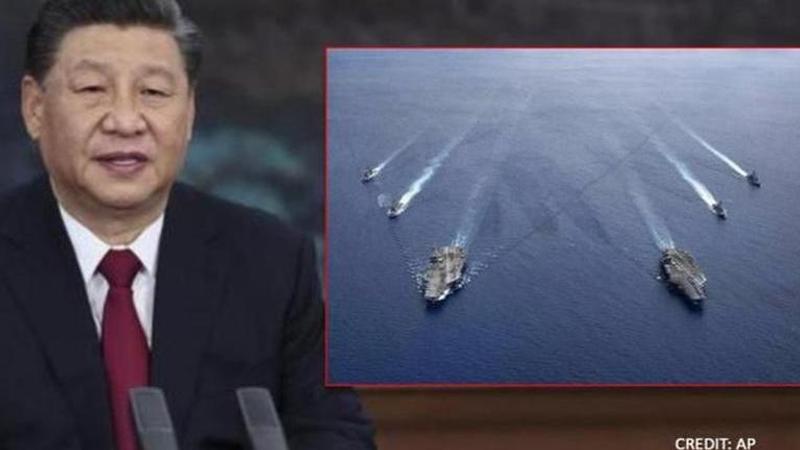Published 20:09 IST, May 2nd 2021
China's homegrown aircraft carrier 'Shandong' holds drills amid South China Sea feud
Shandong, the country's first generation aircraft carrier, recently conducted military exercises in the South China Sea said a navy spokesperson.

A Chinese Navy group, led by Shandong, the country's first generation aircraft carrier, recently conducted military exercises in the South China Sea, said a navy spokesperson. Similar to concerns over China's Coast Guard Laws to serve unilateral sovereignity claim in the Sea, this too can be categorised as contributory factor to China's hegemony assertion in the disputed East Sea alias South China Sea.
Shandong is China's second aircraft carrier and this is the first time it has earmarked on exercises made aware to the general public in 2021, the Global Times reported. Sputnik reported Shandong as China's second aircraft carrier, but the first home made one. China bought bulk of its first aircraft carrier, Liaoning, from Ukraine.
The People's Liberation Army (PLA) Navy or the Chinese Navy spokesperson Gao Xiucheng addressed a news conference,
"The Chinese Navy has recently formed an aircraft carrier group headed by the Shandong to conduct exercises in the South China Sea." He affirmed, "we hope the outside world can view (the Shandong's exercise) objectively and rationally. The PLA Navy will continue to organise similar exercises according to the plan regularly in the future."
He also mentioned these were routine drills that were "completely legitimate" and aimed to enhance the navy's capabilities and safeguard the national sovereignity and security as well as regional stability.
China's Power Projection
The power projection comes in the backdrop of China's ascending maritime activities in South China Sea. Experts have noted this increase in China's presence in the Sea as a response to Beijing's concerns over sizeable increase in US military presence in the region. This has escalated the Sino-US feud.
According to the National Task Force of West Philippines Sea (NTF-WPS) around 220 Chinese fishing ships were monitored to have moored at Whitsun Reef as early as March 7, 2021. The NTF-WPS then reported that the Chinese vessels did not engage in fishing activities. Department of National Defense of Philippines and authorities from Vietnam, both claimant countries of Whitsun Reef alleged China of incursion and issued a demand to China to have the vessels withdraw from Whitsun.
Republic of China's Ministry of Foreign Affairs later disputed these allegations and in return reasoned stalled vessels by saying that fishing boats took shelter at Whitsun Reef due to rough sea and wind conditions sheltering from a storm and insisted that their mooring was normal. Further, China had clarified the Philippines' claim, "there is no Chinese Maritime Militia as alleged. Thus, reasonable and lawful." However, the region's recent fine weather reports around Whitsun Reef debunked the initial excuse from China that they were riding out a storm.
Disputes over the South China Sea, have compelled several foreign entities to outpour their opinions and inculpate China. Now there exist a plethora of territorial disputes between China and its neighbours in the East and South China Seas. Wary countries hooked in territorial disputes with China anticipate basis precedence that latter may interpret internal waters of islands, as territory of its own. Whereas according to China, it is imperative to clarify the positioning of Chinese coast guards, their functions and to convey transparent regulation for international entities thus, when foreign coast guards interact with their Chinese counterparts, they are clear about their actions and potential repercussions.
Tensions in the South China Sea
China has been more assertive in sovereignty disputes of the South China Sea. According to research by the Centre of Strategic and International Studies (CSIS), significant numbers of vessels have been at Whitsun Reef since February 2020. Whitsun Reef is among maritime features in the Spratly Islands in the South China Sea. It is in a shallow coral region of the resource-rich Spratly Islands and is now at the centre of a deepening maritime row between Beijing and Manila. The said islands are subject to a territorial dispute and are in whole or partly claimed by numerous countries, namely, Brunei, China, Malaysia, Philippines, Taiwan and Vietnam.
As no country can exist in vacuum, China has started to face brunt of its domineering side as foreign members accuse China of encroachment and jeopardy. The US Navy strike group also entered the disputed waters after the president of the Philippines, a US ally, voiced concern about the Chinese vessels massing in Manila’s 320km exclusive economic zone. U.S. Secretary of State Antony Blinken last month said. Last week, the European Union inculpated China to have jeopardised peace in the South China Sea. The EU urged all its parties to abide by the ruling of a 2016 tribunal in order to eliminate most of China's claim to sovereignty in the sea.
A 2016 ruling by a United Nations tribunal dismissed China's claim to virtually claim all sovereignty of the South China Sea, though Beijing has refused to recognise the decision. The Chinese statement insisted that China's sovereignty, rights and vested interests in the South China Sea were formed in the 'long course of history and consistent with international law' and rejected the 2016 tribunal ruling as "null and void".
Updated 20:09 IST, May 2nd 2021




